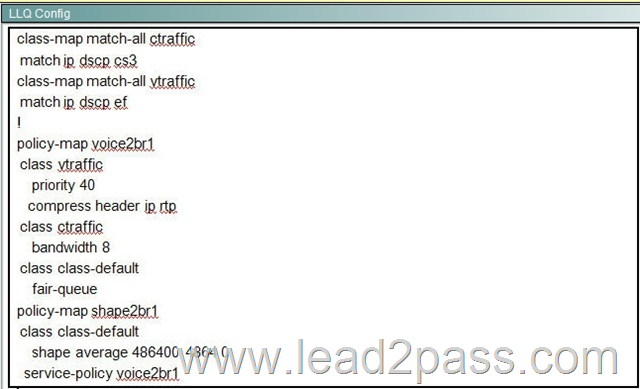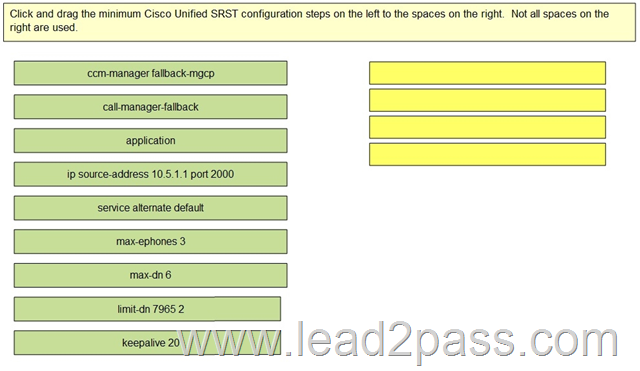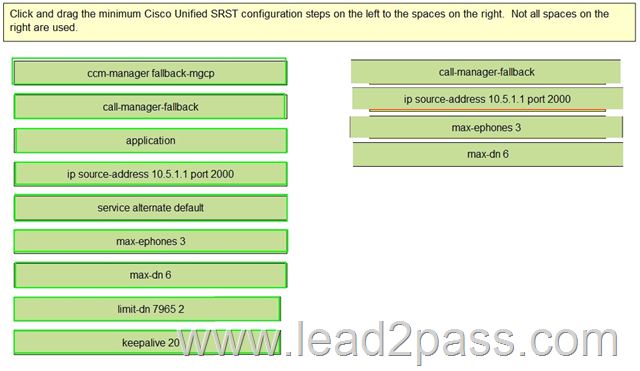2016 November Cisco Official New Released 300-075 Dumps in Lead2pass.com!
100% Free Download! 100% Pass Guaranteed!
Lead2pass is the best place for preparing IT exam as we are providing the latest and guaranteed questions for all certifications. We offer you the ultimate preparation resource of Cisco 300-075 exam questions and answers. Wondering what could be this effective? It is our Cisco 300-075 VCE and PDF which serves as a guide to pass Cisco 300-075 exam.
Following questions and answers are all new published by Cisco Official Exam Center: http://www.lead2pass.com/300-075.html
QUESTION 161
Which statement about enrollment in the IP telephony PKI is true? (Source. Understanding Cisco IP Telephony Authentication and Encryption Fundamentals)
A. CAPF enrollment supports the use of authentication strings.
B. The CAPF itself has to enroll with the Cisco CTL client.
C. LSCs are issued by the Cisco CTL client or by the CAPF.
D. MICs are issued by the CAPF itself or by an external CA.
Answer: A
QUESTION 162
An update of the configuration using the Cisco CTL client not needed when _______.
A. a Cisco Unified CallManager has been removed
B. an LSC of the IP phone is upgraded
C. a security token is added to the system
D. an IP address of the Cisco TFTP server has been changed
Answer: B
QUESTION 163
Which statement is not true about GARP?
A. GARP attacks require access to the target LAN or VLAN.
B. GARP can be used for a man-in-the-middle attack.
C. GARP is normally used for HSRP.
D. GARP can be disabled at Cisco IP phones.
Answer: C
Explanation:
GARP (Gratuitous ARP) announce the presence of IP Phone on the network.
QUESTION 164
Enabling authentication and encryption for CTI, JTAPI, and TAPI applications requires which two tasks? (Choose two.)
A. Enter the encryption key into the application.
B. Set up an IPsec association between the application and Cisco Unified CallManager.
C. Configure related security parameters in the CTI, JTAPI, and TAPI application.
D. Add the application user or end users to the Standard CTI Secure Connection user group, Standard CTI Allow Reception of SRTP Key Material user group, and Standard CTI Enabled user group.
Answer: CD
Explanation:
You must also add the application users or the end users to the Standard CTI Secure Connection user group in Cisco Unified Communications Manager Administration to enable TLS for the application. After you add the user to this group and install the certificate, the application ensures that the user connects via the TLS port.
QUESTION 165
Which two statements about symmetric encryption are true? (Choose two.)
A. With symmetric encryption, the encryption key equals the decryption key.
B. Symmetric encryption is commonly used to sign asymmetric keys.
C. Symmetric encryption is a good choice for real-time encryption of bulk data.
D. Symmetric encryption uses asymmetric keys.
Answer: AC
Explanation:
There are two basic techniques for encrypting information: symmetric encryption (also called secret key encryption) and asymmetric encryption (also called public key encryption.) in symmetric key As long as both sender and recipient know the secret key, they can encrypt and decrypt all messages that use this key. A public key is made freely available to anyone who might want to send you a message. A second, private key is kept secret, so that only you know it.
QUESTION 166
Refer to the exhibit. Locations-based CAC has been configured between HQ and the BR site. Assume that the priority queue has been provisioned correctly for three G.729 calls.
What happens when the fourth call is placed from HO to BR?
A. The call will get through via the WAN. but it will experience poor audio quality.
B. The call will fail.
C. The call will be queued until one of the existing calls drop.
D. The call will get through without any issues.
Answer: B
QUESTION 167
Video calls using 384 kbps need to be supported across a gatekeeper-controlled trunk. What value should be entered into the gatekeeper to support this bandwidth?
A. 768 kbps
B. 384 kbps
C. 512 kbps
D. 192 kbps
Answer: B
Explanation:
A 384-kb/s video call may comprise G.711 at 64 kb/s (for audio) plus 320 kb/s (for video).
This sum does not include overhead. If the audio codec for a video call is G.729 (at 24 kb/s), the video rate increases to maintain a total bandwidth of 384 kb/s.
QUESTION 168
In what Cisco solution is Simple Network-Enabled Auto Provision technology used?
A. Cisco Unified Gateway Duplication
B. Cisco Unified CallManager Redundancy
C. Cisco Unified SRST
D. Cisco Unified Call Survivability
Answer: C
Explanation:
When the system automatically detects a failure, Cisco Unified SRST uses Simple Network Auto Provisioning (SNAP) technology to auto-configure a branch office router to provide call processing for the Cisco Unified IP phones that are registered with the router.
QUESTION 169
While configuring Call Survivability in Cisco Unified Communications Manager, what step is mandatory to reach remote sites while in SRST mode?
A. Enable Cisco Remote Site Reachability.
B. Configure CFUR.
C. Enable the SRST checkbox in the MGCP gateway.
D. Configure the H.323 gateway for SRST in Cisco Unified Communications Manager.
E. Enable the Failover Service parameter.
Answer: B
Explanation:
Call Forward Unregistered (CFUR) functionality provides the automated rerouting of calls through the PSTN when an endpoint is considered unregistered due to a remote WAN link failure.
QUESTION 170
While operating in SRST, what is needed to route calls outside of the remote site location to the PSTN?
A. SIP trunk
B. CallManager route patterns
C. translation patterns
D. POTS dial peers
E. VOIP dial peers
Answer: D
Explanation:
in time of srst configuration on router, please configure a dial-peer so that call flow in SRST mode.
QUESTION 171
When using Cisco Unified Communications Manager Express in SRST mode, how many multicast music on hold streams can be utilized by the system at any given time?
A. 3
B. 6
C. 2
D. 4
E. 1
F. 5
Answer: B
QUESTION 172
To preserve analog calls in an MGCP switchback event, which three commands must be configured in the MGCP fallback router? (Choose three.)
A. h323
B. mgcp-switchback-graceful
C. voice service voip
D. mgcp-graceful
E. preserve-h323
F. no h225 timeout keepalive
Answer: ACF
QUESTION 173
Which two locations are the best locations that an end user can use to determine if an IP phone is working in SRST mode? (Choose two.)
A. Cisco Unified Communications Manager Administration
B. IP phone display
C. Cisco Unified SRST Router
D. Cisco Unified MGCP Fallback Router
E. physical IP phone settings
Answer: BE
Explanation:
IP Phone display and Physical phone IP settings are two locations were an end user can determine if an IP phone is working in SRST mode.
QUESTION 174
What is the fastest way for an engineer to test the implementation of SRST in a production environment?
A. Shut down the Cisco Unified Communications Manager Servers.
B. Shut down the switch ports connected to the Cisco Unified Communications Manager Servers.
C. Add a null route to the publisher Cisco Unified Communications Manager at the remote router.
Remove the null route when the operation is verified.
D. Unplug the IP phones from their switch ports.
E. Verification is not needed.
Answer: C
QUESTION 175
Drag and Drop Question
Answer:
QUESTION 176
You are the Cisco Unified Communications Manager in Certpaper.com.
You use a remote site MGCP gateway to provide redundancy when connectivity to the central Cisco Unified Communications Manager cluster is lost.
How to enable IP phones to establish calls to the PSTN when they have registered with the gateway? (Choose three.)
A. POTS dial peers must be added to the gateway to route calls from the IP phones to the PSTN.
B. The default service must be enabled globally.
C. The command ccm-manager mgcp-fallback must be configured.
D. COR needs to be configured to disallow outbound calls.
Answer: ABC
QUESTION 177
Which two configurations provide the best SIP trunk redundancy with Cisco Unified Communications Manager? (Choose two.)
A. Configure all SIP trunks with DNS SRV
B. Configure all SIP trunks with Cisco Unified Border Element
C. Configure all SIP trunks to point to a SIP gateway
D. Configure SIP trunks to be members of route groups and route lists
E. Configure all SIP trunks to allow TCP ports 5060
F. Configure all SIP trunks to point to a gatekeeper through SIP to H.323 gateway
Answer: AD
Explanation:
For SIP trunks, Cisco Unified Communications Manager supports up to 16 IP addresses for each DNS SRV and up to 10 IP addresses for each DNS host name. The order of the IP addresses depends on the DNS response and may be identical in each DNS query. The OPTIONS request may go to a different set of remote destinations each time if a DNS SRV record (configured on the SIP trunk) resolves to more than 16 IP addresses, or if a host name (configured on the SIP trunk) resolves to more than 10 IP addresses. Thus, the status of a SIP trunk may change because of a change in the way a DNS query gets resolved, not because of any change in the status of any of the remote destinations.
QUESTION 178
When you configure Cisco Unified Communications Manager, you need to configure the router for Survivable Remote Site Telephony in case the Cisco Unified Communications Manger stops working. On which two factors would the number of IP phones and Directory Numbers that can register to the SRST router depend? (Choose two.)
A. The protocol that is used in Cisco Unified Communications Manager
B. Cisco Unified Communications Manager version
C. Cisco IOS Software version
D. WAN link bandwidth
E. capacity of the Cisco Media Convergence Server
F. router platform
Answer: CF
QUESTION 179
Which remote-site redundancy technology fails over to POTS dial peers from the Cisco Unified Communications Manager dial plan during a WAN failure?
A. MGCP fallback
B. H.323 fallback
C. SCCP fallback
D. SIP fallback
Answer: A
QUESTION 180
How does the system intelligently shift call processing upon restoration of WAN connectivity?
A. automatically back to the primary Cisco Unified Communications Manager cluster
B. manually back to the primary Cisco Unified Communications Manager cluster
C. automatically back to the secondary Cisco Unified Communications Manager cluster
D. manually back to the secondary Cisco Unified Communications Manager cluster
Answer: A
Practise Lead2pass 300-075 braindumps and pass your exam easily. Lead2pass is number one company for real exam dumps. Download Lead2pass 300-075 exam questions and answers PDF file and prepare from our study material.
300-075 new questions on Google Drive: https://drive.google.com/open?id=0B3Syig5i8gpDZi1ZVXhiQWtBSFU
2016 Cisco 300-075 exam dumps (All 356 Q&As) from Lead2pass:
http://www.lead2pass.com/300-075.html [100% Exam Pass Guaranteed]



